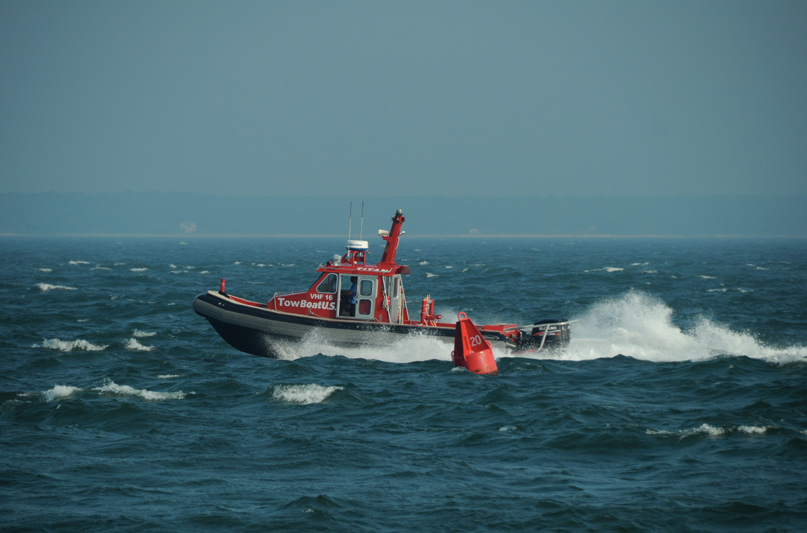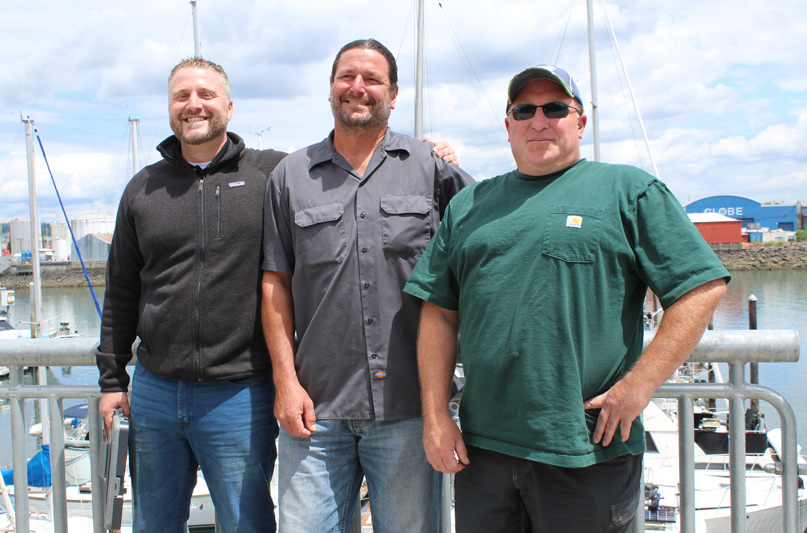“Look for the helpers. You will always find people who are helping.”
-Fred Rogers [aka Mr. Rogers] quoting his mother’s advice for handling disasters
 The simple truth about boating is that someday you’re going to need a tow. Maybe you’ll be like me when I needed a tow, a newbie owner of a ragged 1973-vintage Catalina 27 stranded on a mangrove island in Tampa Bay after an old anchor rode failure. Maybe you’ll have decades of boat experience and be doing everything right, yet you experience engine troubles anyway. Those of you nodding your heads in agreement get it while the defiant among you secretly know your time is coming.
The simple truth about boating is that someday you’re going to need a tow. Maybe you’ll be like me when I needed a tow, a newbie owner of a ragged 1973-vintage Catalina 27 stranded on a mangrove island in Tampa Bay after an old anchor rode failure. Maybe you’ll have decades of boat experience and be doing everything right, yet you experience engine troubles anyway. Those of you nodding your heads in agreement get it while the defiant among you secretly know your time is coming.
The topic of towing is interesting because most tow companies will do more than simply tow disabled vessels. These companies fill an important gap in vessel distress situations by responding to incidents that are above the owner/operator’s capability to address yet not quite at the life threatening or massive property damage level that require a U.S. Coast Guard (USCG) response.
If you’re out of gas because your fuel gauge malfunctioned, how can you get a precious ten gallons in the tank so you can get to the nearest fuel dock? If you just need a battery jump and the only Good Samaritan you flag down doesn’t have jumper cables either, what do you do?
It is these situations where companies like the ones that partner with the TowBoatUS network shine, providing a level of security on the water that can turn a potentially dangerous situation into a story-worthy inconvenience.
Because it’s July and peak boating (and boating accident) season, I reached out to the local tow boat captains of TowBoatUS Puget Sound—a BoatUS partner—to learn more about how to be prepared for those worst-case scenarios. Three of them—Chris Conti, Chris Justice, and Sam Ginn—were gracious enough to chat by the Thea Foss Waterway of Tacoma about all that they do: fire response, search and rescue assistance, fuel delivery, salvage, ungroundings, and of course, towing.
NWY: So TowBoatUS Puget Sound is part of the BoatUS network. How exactly does that partnership work?
CONTI: We, and all the towing companies that work with BoatUS, are essentially subcontractors for BoatUS and Geico insurance companies. Being partnered with them gives us first right of refusal for towing their members. In addition to towing, we get dispatched to do salvage work through the BoatUS and Geico insurances companies, as well as others who are out there. We basically do work for any insurance company, but we’re contracted through BoatUS and Geico.
NWY: When it comes to any given response case, what’s the behind-the-scenes chain of events? How many people are involved in any given tow?
CONTI: It varies. There are multiple different avenues that we can get dispatched through. Some come through directly from the boaters; they have our number from a business card, or they Google our phone numbers through the web. Other times we get calls from the Coast Guard Station Seattle and they dispatch us depending on the situation. It can depend on factors like if the vessel in distress is in a traffic lane or there is heavy weather, like overheating and taking on water, or something like that.
We also have three dispatch centers for BoatUS: ones in Southern California, Virginia, and Florida. The phone calls get routed to one of those centers and one of many dispatchers will call us and send us. Also, just by being out there running around all the time, people in distress flag us down all the time.
NWY: Obviously, nobody wants to ever need a tow. Do you have any tips to avoiding a towing situation in the first place?
JUSTICE: I’d say maintaining boats saves a lot of the tows. Most of it’s [boat problems that lead to a tow] maintenance related. Sometimes it’s a problem you can’t foresee, but proper boat maintenance is probably the number one owners can do to avoid a tow.
CONTI: Checking the engine before going out, especially if it’s been idle for a while. Make sure the systems are working. One of the most common problems we have that results in a tow is fuel. When it comes to fuel gauges on boats, a lot of them are inaccurate or inoperable. A lot of people are guessing how much fuel they have in their tanks, so we end up doing a lot of fuel deliveries.
When it’s diesel, a lot of the time delivering fuel like normal won’t help because they’ve run the system completely dry. A diesel system must be re-primed which is something we normally won’t do on the water and instead bring them to a certified marine mechanic to take care of the re-prime. Some of us do know how to do it because we run diesel boats, but we tend not to get into the mechanic side of things on people’s boats.
NWY: What’s the limit of what you all do out there? It seems like there is a fine line between something being a part of the job and above and beyond.
CONTI: A lot of the time we limit what we do to tow customers in. Fuel delivery is getting a little trickier due to environmental regulations. The cans we use are dripless, but back when I first started we had the standard fuel cans of the day that would almost always leak no matter what you did. So that’s an improvement.
Some areas I just won’t deliver fuel because my fuel cans get stolen on a regular basis. I’ve had to give up on a few areas [with regards to fuel deliveries] over the years until we could get into a more secure dock space, as people would come over to borrow fuel without asking. They’d leave some cash and a note aboard and think we were even.
JUSTICE: Part of the need for fuel deliveries is that there’s limited fuel docks on the water around here.
GINN: Yeah. Also, when everything’s closed, that little bit of gas we bring can be somebody’s lifeline.
CONTI: We usually only carry about 10 gallons. If that doesn’t do it, we’ll end up towing them.
JUSTICE: I personally always carry 10 gallons of backup fuel. I think it’s common sense for all boaters.
NWY: How important is that local knowledge to what you all do? Does being local boaters help?
CONTI: Local knowledge is vital to what we do. We tow customers into the port of their choice if possible, but in heavy weather there are some marinas around here that are pretty treacherous to get into while you have someone side tied to your boat. Des Moines can be bad with a southwest wind, same with Tyee. Edmonds is another one that can be bad in five-foot or more seas. It’s pretty much impossible.
NWY: Are conditions such that you guys make no-go decisions, or are those rare?
JUSTICE: No-gos are very rare.
CONTI: Most of the time we just do it and wish we hadn’t later. I had one like that this last winter where we were just stuck in a side tie. The waves were slamming us together. I picked him up at Brown’s Point and went to Des Moines. We made it, but it was really bad.
NWY: What kind of boats do you guys usually run? What makes a good tow boat?
JUSTICE: We have a variety of different ones. The type of boat is less important than having it rigged for towing. I’ve run most of ours and they’re all a little different, but if it’s rigged up for towing, it’s good.
GINN: Rigged for towing means bar over the outboard engines [to keep towlines off the motors], a towline post, tow lights, etc.
CONTI: Basically, everything we need to be legal under USCG regulations. I have been trying to switch to all twin outboard driven boats just because the technology for the outboards these days has gotten so good compared to what it used to be 20 years ago. One of my boats has twin Yamahas on it and those things are just flawless. Haven’t had any problems with them in the last three years; very dependable. I’m trying to switch all the boats to be like that.
NWY: What’s the process like? Walk us through a textbook tow.
JUSTICE: You pull up alongside initially. It depends on the situation and people on the boat, but if it’s calm, I’ll just go up and tie the bridle myself. If it’s rough, I’ll toss a line to the person on board and they’ll rig it up. Then you tie it on and tow them. If it’s rough out, I’ll give them more line. Once we get close to our destination, I’ll go back to a side-tie to get them into a marina slip or dock. The side tie is much more maneuverable.
CONTI: We usually get a signature afterwards, but once we’re hooked on, we consider it our responsibility.
NWY: I bet you guys have some pretty crazy stories. Care to share?
GINN: Yesterday, I had an interesting case. It was during a small craft advisory for a 34’ Columbia sailboat. He was just off Point Defiance and the entrance to Gig Harbor, and it was blowing pretty good at that time. The tidal exchange just started, but it was just choppy. He has nothing to tie to! He had taken off his cleats and everything because he was working on his boat. I was like, ‘what do I use?!’
I ended up tying up to the mast and using the bow pulpit as a sort of guide for the line to keep the sailboat pointed in the right direction. I couldn’t just pull off the mast or that sailboat could turn sideways, which isn’t good obviously. Super interesting situation. I told the guy to stay at the helm and steer to follow me.
Once I got near Tyee [the destination], we had to pass the container ships. Super gnarly water, a real washing machine. I usually would side tie him there before entering the marina, but in this case, I just shortened the line and told the guy to steer with me as we thread the needle. Once we got in, we side tied the best we could and worked him in. Super interesting.
Part II of this story continues next month!

